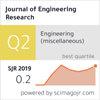用不同结构的单一和多种材料制造的增材制造机械结构的性能表征
IF 0.9
4区 工程技术
Q3 ENGINEERING, MULTIDISCIPLINARY
引用次数: 0
摘要
目前,轻量化对于减少燃料消耗和提高航空航天飞行器的飞行续航力具有越来越重要的意义。本研究旨在应用多材料增材制造技术在不影响翼梁结构完整性的情况下实现上述目标。为了进行概念验证,采用两种聚合物基材料,即丙烯腈-丁二烯-苯乙烯(ABS)和碳纤维增强聚乳酸(CF-PLA),以不同的结构打印单一和多种材料的翼梁。考虑到外表面的弯曲应力较大,梁的外结构采用CF-PLA打印,因为它具有更高的强度。然而,内部结构,即接近中性面,是在低密度ABS打印,从而产生高强度重量比翼梁。测试了打印梁的载荷重量比、刚度重量比和能量吸收性能。结果表明,与ABS梁相比,复合材料梁的承载能力提高了109 %,吸能能力提高了76 %。并对有限元分析(FEA)模拟梁结构性能的适用性进行了验证。数值计算结果与实验结果吻合较好,从而证实了有限元分析可以作为一种可靠的工具来测试和调整任何多材料梁的性能,而无需进行实验。本文章由计算机程序翻译,如有差异,请以英文原文为准。
Performance characterization of an additively manufactured mechanical structure produced in single and multiple materials with varying configurations
Nowadays light weighting is gaining increasing importance to minimize fuel consumption and improve flight endurance of aerial and space vehicles. The present study aims to apply multi-material additive manufacturing to achieve the mentioned objective in a wing spar without compromising its structural integrity. For concept proofing, two polymer-based materials namely Acrylonitrile Butadiene Styrene (ABS) and Carbon Fiber reinforced Polylactic Acid (CF-PLA) were employed for printing a wing spar in single and multiple materials with varying configurations. Given larger bending stresses on the outer surfaces, the outer structure of the spar was printed in CF-PLA as it has higher strength. However, the inner structure, i.e., close to the neutral plane, was printed in low-density ABS thereby resulting in high strength-to-weight ratio wing spars. The performance of the printed spars was tested in terms of load-to-weight ratio, stiffness-to-weight ratio, and energy absorbed. The results revealed that the multi-material spars interestingly exhibited improved performance, which compared with that of the ABS spars was 109 % greater in terms of load-bearing capacity and 76 % better in terms of energy absorption ability. The suitability of Finite Element Analysis (FEA) to simulate the performance of spars was also examined. The numerical results were in good agreement with the experimental ones thereby confirming that the FEA can be employed as a reliable tool to test and tailor the performance of any multi-material spar without performing experiments.
求助全文
通过发布文献求助,成功后即可免费获取论文全文。
去求助
来源期刊

Journal of Engineering Research
ENGINEERING, MULTIDISCIPLINARY-
CiteScore
1.60
自引率
10.00%
发文量
181
审稿时长
20 weeks
期刊介绍:
Journal of Engineering Research (JER) is a international, peer reviewed journal which publishes full length original research papers, reviews, case studies related to all areas of Engineering such as: Civil, Mechanical, Industrial, Electrical, Computer, Chemical, Petroleum, Aerospace, Architectural, Biomedical, Coastal, Environmental, Marine & Ocean, Metallurgical & Materials, software, Surveying, Systems and Manufacturing Engineering. In particular, JER focuses on innovative approaches and methods that contribute to solving the environmental and manufacturing problems, which exist primarily in the Arabian Gulf region and the Middle East countries. Kuwait University used to publish the Journal "Kuwait Journal of Science and Engineering" (ISSN: 1024-8684), which included Science and Engineering articles since 1974. In 2011 the decision was taken to split KJSE into two independent Journals - "Journal of Engineering Research "(JER) and "Kuwait Journal of Science" (KJS).
 求助内容:
求助内容: 应助结果提醒方式:
应助结果提醒方式:


